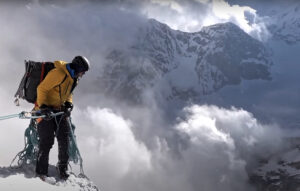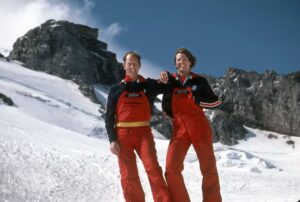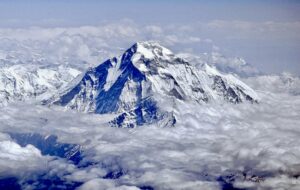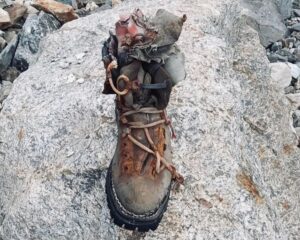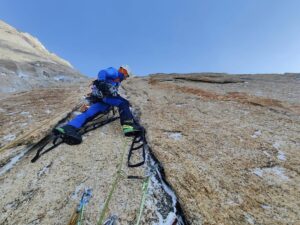Last month, events on Rakaposhi and Manaslu overshadowed the quiet achievements of a small team that climbed an isolated peak in the Hindu Kush.
Archil Badriashvili, Baqar Gelashvili, and Georgi Tepnadze of Georgia had no way to communicate with the outer world. They focused fully on the mountain’s sheer rocky face. They needed no rescue and stayed far from any controversy. But their first ascent on the rarely attempted and never completed Saraghrar will end up on the shortlist for Best of the Year.

The massif of Saraghrar. Photo: Archil Badriashvili
Team leader Archil Badriashvili has shared a complete report on the climb. Still, we wanted to know more about the team’s background and the expedition and its exotic location in the Rosh Gol Valley. This hidden corner of the world is close enough to war-torn Afghanistan to keep many expeditions away. It’s also remote enough to attract only small, self-sufficient teams.
The Rosh Gol valley, on the border between Afghanistan and Pakistan, is one of the forgotten treasures of Hindu Kush. It is a beautiful place surrounded by four steep 6,000m and 7,000m peaks. The massive Saraghrar mountain has more than a handful of summits (with the main summit rising up to 7,349m), resembling a crown of the massif. The only unclimbed summit was the NW point, at 7,300m. It looks exceptionally beautiful from the valley. The NW face looked logical and caught our interest at first sight. — Archil Badriashvili

Archil Badriashvili, left,
Interview with Archil Badriashvili
Why did you choose Saraghrar and how long did it take to prepare for an expedition to such a remote place?
The preparation began a year ago, soon after we studied the region and discovered the Hindu Kush’s Rosh Gol Valley. It was something different from what we’ve seen before in the Himalaya and even in the Karakorum. Preparations started by climbing in the Caucasus. Then we did a Makalu expedition last spring, then straight back to technical summer ascents, plus some sport and mixed climbing.
The Hindu Kush is not exactly a popular climbing spot. Why do so few climbers come here?
The mountains are huge, steep, and perhaps interesting only for extreme alpinists. After the Soviet-Afghan war, there was very little activity in the Hindu Kush. Saraghrar, for instance, is the most attractive peak in that area, but I found only two ascents since the 1970s. This and the ongoing war in nearby Afghanistan might be a reason for ignoring this part of Pakistan. But in fact, we enjoyed people’s hospitality throughout the whole journey.

The Georgians’ route on Languta-e-Barfi. Photo: Archil Badriashvili
Before Saraghrar, did you climb other peaks in the area for acclimatization?
Yes, we needed to acclimatize, so first, we visited “the Bride of the Hindu Kush”, Languta-e-Barfi, and climbed it on August 25. It’s a white, beautiful mountain, always bright white, covered in ice and snow. It stands out and it is visible from all over the valley. We climbed its south face, on the Pakistani side of the mountain. A New Zealand expedition attempted it in 2014, but they turned around at the summit ridge.
Languta-e-Barfi’s moderate level of difficulty allowed us to climb fast and light, and to properly adapt to altitude. At the foot of the mountain, we chose the right-hand slope of the face as our line. That same night, we started.
The slope became increasingly steep as we climbed higher. The upper half was mostly dried-out ice, mixed with sand and stones, around 60°. That day we gained 1,400m, climbing all the way up to the ridge at about 6,400m. The next climbing day, we made it to the summit. For the first time, we looked out on the Afghan side of the massif. The same day, we rappelled down the face.

Camp at the foot of the NW Face of Saraghrar. Photo: Archil Badriashvili
Once you arrived at Saraghrar, did you have a clear idea about which line to follow on that massive face? Tell us about the route.
We had three potential lines of ascent to consider. Of course, the reality was different once we were there. The line we finally chose was longer and more complex than expected. The idea to use the colder days of late August and September was an experiment in itself, as I had found no autumn reports. Still, the plan worked well for us.

On Saraghrar’s NW face at 6,900m. Photo: Archil Badriashvili
The ascent was intense and diverse. At first, we followed a “supercouloir”. On the second day, we continued up the walls on the left. We spent the next days climbing dozens of granite walls, super complex. Some days, we could only advance two or three pitches!
We spent the nights on tiny ledges in our single-wall tent. Once, we had to stay outside, in a very exposed place. The wall finally ended at around 7,130m, with the hardest pitches so far. From there, a corniced, blade-sharp ridge led us to the “NW II”, climbed by a Catalan team in 1982. We camped near their high point. The following morning was windy and cloudy. Our work toward the summit involved trail breaking, some steep firn, and a very last mixed pitch. Then finally, we were on the top, and very happy!
Did you, at any point, consider the conditions too difficult or too risky?
Both! We had constant technical difficulties. There were risky moments, too. On the wall, we had to deal with some crazy pitches and experienced moments of uncertainty, too. Luckily, never for too long. You can imagine that when you feel good but can’t climb more than three pitches a day for a couple of days. And half the bivouacs were…horrible!

Difficulties didn’t end after the rocky face. Above, a tricky ridge at 7,100m. Photo: Archil Badriashvili
Another issue was the descent. We explored all variants and chose the safest option — to descend the same face. We managed it in a day, rappelling some 35 times non-stop to the foot of the mountain.
By the time you were on Saraghrar, an emergency on Rakaposhi needed rescuers, and there was a call for help from any other acclimatized climbers in Pakistan. You responded to the call, right?
In the evening after we returned to Base Camp, we learned of the situation on Rakaposhi and signaled that we were ready to help. Thankfully, local men managed to finish the operation successfully. As for the controversy…The most important thing is that those climbers got out alive.
Tell us about the team. You guys have climbed some very interesting routes together: How is it that you don’t have that much press?
Our Georgian team is amazing, we all enjoy each other. Giorgi Tepnadze is relentless: We have been climbing for eight years and have done our best work together. Baqar Gelashvili has been with us for most of our Himalayan climbs. Both Giorgi and Baqar work as ski rescuers. I am a part-time MD and organizer for our expeditions. We all guide in the mountains.

The Georgians atop Languta-e-Barfi. Photo: Archil Badriashvili
As for the press…there must be several reasons why we’re not often in the spotlight. One, our climbs (and life in general) were hidden when Georgia was not free (independent), and the hard years continued after independence. And personally, we started to send reports of our trips regularly in 2017, mostly to the American Alpine Journal and some media, now and then.
Manaslu has been in the news a lot lately. You have climbed in that area, but instead of Manaslu itself, you chose virgin peaks nearby. I guess you don’t like crowds?
Ah, Manaslu…We’ve seen that great mountain from very interesting angles. Giorgi, Baqar, and I have climbed three virgin peaks over two expeditions to that region. But we also had plenty of time to exchange thoughts about Manaslu’s many faces and possibilities.
Most of the climbs we have done took place in non-crowded corners. Manaslu, on the contrary, is now one of the most overcrowded high-altitude peaks, together with Everest. To be honest, one of the things I enjoy the most is watching fresh spectacular panoramas over “our peaks” [which, around Manaslu, were Larkya I, Pangpoche I, and Pangpoche II-s].
What’s next for you and your team?
Giorgi and I are looking forward to returning to the highest mountains. Previously we have had autumn and summer expeditions to Nanga Parbat in 2019 and Makalu this year. We loved the mountains we have visited and still have some magnificent 8,000’ers in our crosshairs, but time will tell!

The Georgian team’s new route on Saraghrar last month. Photo: Archil Badriashvili


